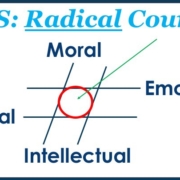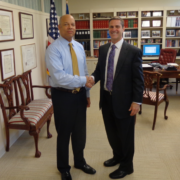RADICAL-COURAGE
RADICAL COURAGE
“To be a better leader, never be the bearer of bad news” was the advice a senior executive in a large financial management firm had given to my colleague – who has been a dear friend for many years and a fellow veteran. My friend related the story to me in a WTF sort-of-manner. It grated against the most basic elements of leadership. He was counseled to forget about courage.
Unpacking what the senior executive said, we realized that his advice was perfectly sound for someone whose primary aim was climbing the corporate latter: make no waves, avoid being seen as a threat, have other people do the dirty work. Remove your spine. But as leadership advice, it was appalling.
Courage is the backbone of sound leadership. It is the virtue, according to the ancient Greeks and Romans, that allows all other virtues to exist.
How does this apply to business and nonprofit leaders? Courage enables leaders to set an example by:
- Sharing hardships with employees so they respect you as caring and in touch
- Doing what is morally and ethically right so you build trust in your employees and customers
- Facing situations of high anxiety and trepidation so you create faith and confidence that you will tackle tough challenges
- Demonstrating sound judgment in a dynamic marketplace so you can seize opportunities and manage unforeseen threats.
Leaders who set an example in these ways have what we call Radical Courage. Radical Courage is the integration of four types of courage: physical, moral, emotional, and intellectual. The descriptor “Radical” expresses an idea both basic and profound – leaders require multiple forms of courage.
We commonly think of courage in the physical sense: a soldier facing the enemy on the battlefield or a firefighter charging into a burning building to rescue a child. For most leaders, the need for physical courage takes on less dramatic but no less important aspects.
Imagine leaders who surround themselves with luxury and work in an environment far more comfortable than their employees. They are more likely to be seen as distant, detached, and out-of-touch. Leaders who require employees to work with shoddy materials in an unsafe or unhealthy work environment will probably find significant resentment.
Leaders who share hardships with their employees are more likely to be considered genuine and authentic. They are less likely to tolerate huge disparities or an unhealthy, unsafe work environment. Ray Lambert, a World War Two veteran and founder of Lambert Electric, told me that he insisted on being on-site when his employees were working late or with a new client or on a high-risk job. He wanted to make sure they had the materials, support, and conditions needed to do their jobs to the right standard and safely. He retained a highly loyal workforce and a group of clients. That veteran-owned business thrived for over 40 years until he sold it upon retirement.
Moral courage, on the other hand, is the willingness to uphold moral and ethical standards despite pressure to do otherwise. Business and nonprofit leaders can face these challenges in areas such as finance, accounting, and reporting. Leaders should also beware of creating an environment that places employees in a position that encourages moral or ethical compromise.
Volkswagen’s “no failure” culture, under which almost no employee mistakes were tolerated, reportedly led to practices that undermined honest communication and accountability. For instance, Volkswagen managers discovered that their diesel engines were producing emissions above standards. Rather than report and fix the problem (and face potential consequences), managers instead installed devices designed to fool emissions tests. Senior leaders allegedly covered up these actions in an effort to avoid public embarrassment and the cost of recalling and fixing the engines. The decision by Volkswagen managers to falsify emissions test results, and by the leadership to cover up the cheating, are failures of moral courage.
Two other forms of courage that are less well-known are emotional and intellectual. Emotional courage is the willingness to face high anxiety situations without being cold-hearted or carried away by anger, rage, elation, etc. In 2014, Mary Barra, the first female CEO of a major American automobile company, showed emotional courage in facing public outcry and congressional scrutiny over GM’s faulty ignition switches. Barra not only came forward to acknowledge the responsibility personally, but she also took proactive actions to turn the crisis into an opportunity for major organizational reform.
Intellectual courage is the foundation of good judgment. It is a balance between the strength of conviction and flexibility. Leaders who lean too far toward conviction can become obstinate, bull-headed, and impervious to feedback. So many warning signs about Uber’s toxic culture and questionable practices were ignored by former CEO Travis Kalanick and the Board of Directors, leading to a major crash for a company that had achieved the highest valuation of any start-up in history. Excessive flexibility, on the other hand, can create indecisiveness (losing the courage to act) or hyperactivity – over-reacting to every conflicting or contradictory data point.
Each element of courage is a balance between extremes and a willingness to face some form of danger or harm. Radical Courage is the integration of all four. Imagine a hashtag. Each line represents one of the four forms of courage. Radical courage is the space in the center.

How can leaders improve each element of courage? Let’s return to the ancient Greeks and Romans. They believe that virtue is a habit – the sum total of our daily choices of right and wrong. Therefore, leaders build radical courage through daily practice. Ask yourself these questions:
- Am I sharing the hardships and challenges of my employees?
- Do my decisions uphold our values and code of ethics?
- Do my expectations promote greater candor or incentives to hide the truth?
- Am I willing to be the bearer of, or face up to, bad news?
- How do I know when to change my mind or alter a plan?
Radical courage is a pivotal distinction between a leader and a corporate climber. Leading with Radical Courage increases your trustworthiness in the eyes of your employees and customers; it guides you when you have to face tough decisions or confront difficult truths; it helps you determine when to stick to your plan and when to change it. These qualities are essential for leaders who want their small businesses or nonprofits to grow sustainably in a competitive, dynamic market.









